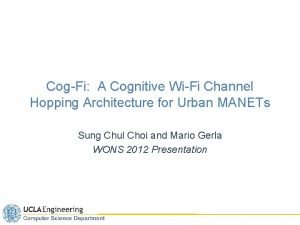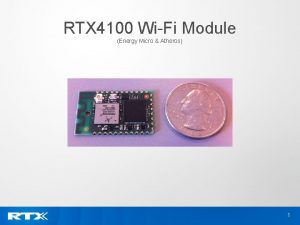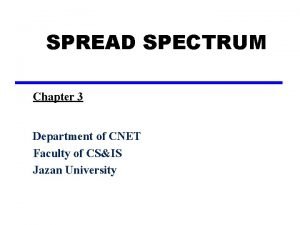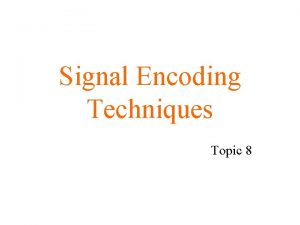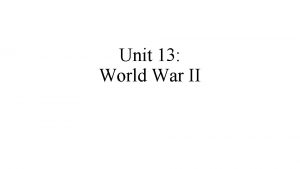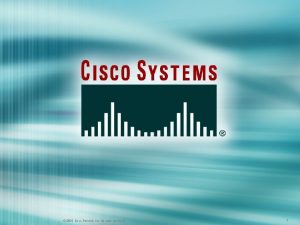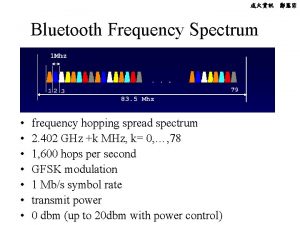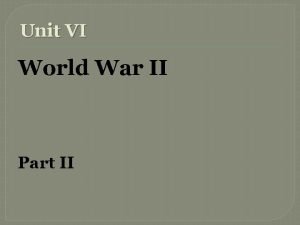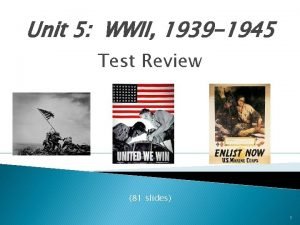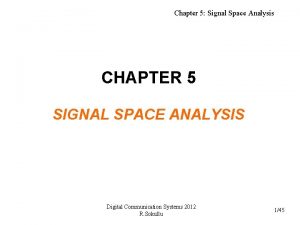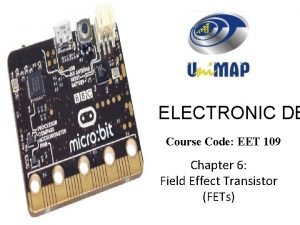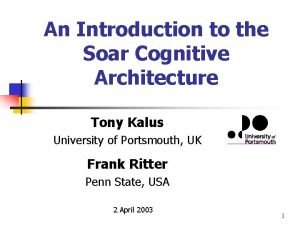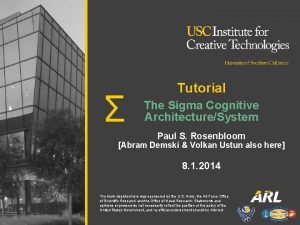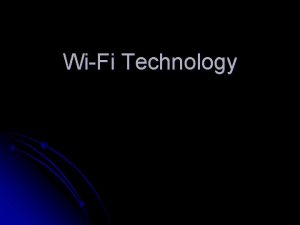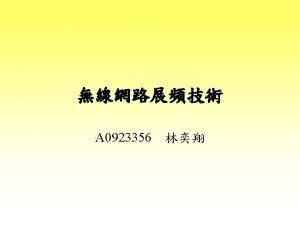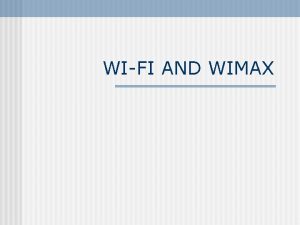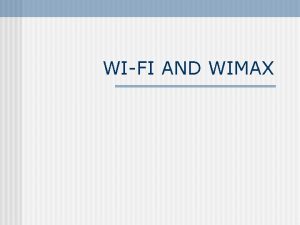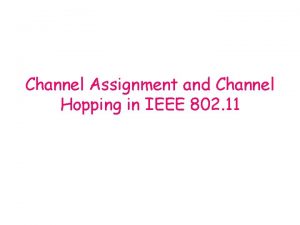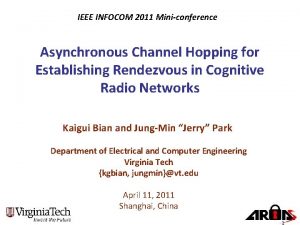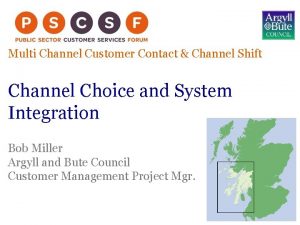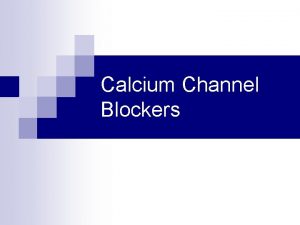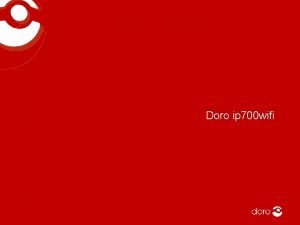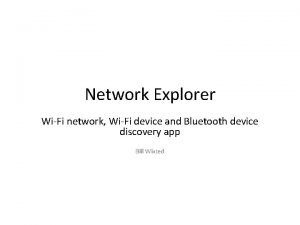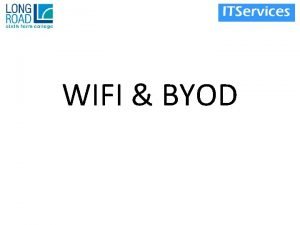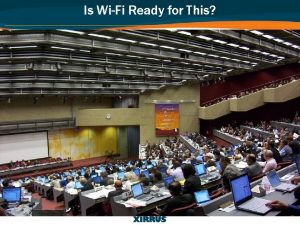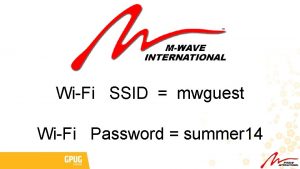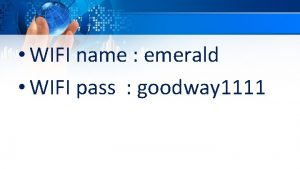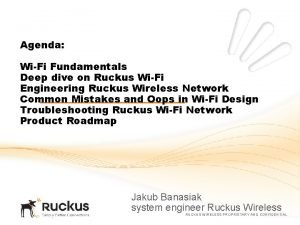CogFi A Cognitive WiFi Channel Hopping Architecture for




















![CH-LQSR: ETTCH Metric u e v q Extend ETX and ETT [4, 5]. § CH-LQSR: ETTCH Metric u e v q Extend ETX and ETT [4, 5]. §](https://slidetodoc.com/presentation_image_h/0f0b0371fd38c5571efaa237a5fb73af/image-21.jpg)




![Cog-Fi: Evaluation Setup [COG] for single-radio nodes q List of schemes compared for evaluation Cog-Fi: Evaluation Setup [COG] for single-radio nodes q List of schemes compared for evaluation](https://slidetodoc.com/presentation_image_h/0f0b0371fd38c5571efaa237a5fb73af/image-26.jpg)




- Slides: 30

Cog-Fi: A Cognitive Wi-Fi Channel Hopping Architecture for Urban MANETs Sung Chul Choi and Mario Gerla WONS 2012 Presentation

Motivation 2

Motivation 3

Network Model Mobile node Fixed Interfering source 4

Network Model Network node ch 8 Interfering source 3 5 1 4 • Goal: 1 Avoid the channels used by interfering sources using a cognitive multi-channel scheme. 5

Solution Preview q To avoid interfering sources: § Use Cognitive radio technology to sense channel load and discover lightly loaded channels q To maintain P 2 P network connectivity in spite of unpredictable interferers: § Exploit multi channel diversity: a node can receive on multiple channels via Cognitive Channel Hopping § Guarantee neighbor discovery and rendezvous in a finite # of steps(using the QUORUM set) § Design routing algorithm that accounts for “multichannel links” and Channel Hopping 8

Cognitive Channel Hopping q Cognitive Channel Hopping (CCH) § Single-radio, channel-hopping solution in which each node picks its channels based on the load sensed on them f f t f t t 9

CCH: Protocol Operation q A node x periodically triggers Channel Quality Assessment (CQA). § A channel availability vector a = {a 1, …, a|C|} is produced. • In this work, ai = 1 - [channel load in i]. § Based on channel availabilities, x picks a channel set Q = {q 1, …, qk} from a predefined Quorum list (any two Q-sets have at least one common element) C = {0, 1, 2, … , 11, 12} § It picks the channel set with the highest combined channel quality, defined as: Example list of channel sets, each with size k = 5. 13

CCH: Protocol Operation q Given Q, x generates two hopping sequences, utx and urx. Mrx Mtx Q = {0, 1, 3, 9, 12} k=5 0 1 3 9 12 0 1 3 9 12 0 1 3 9 12 12 0 1 3 9 utx 0 1 3 9 12 0 1 3 … urx 0 1 3 9 12 0 1 9 12 0 … |utx| = |urx| = k 2 = 25 14

CCH: Channel Rendezvous Property q Claim: A channel rendezvous of a pair of nodes is guaranteed to occur within k 2 slots. Qx = {0, 1, 2} Qy = {2, 3, 4} By the property of a quorum system, there exists at least one common channel. utx(x) … Mtx(x) Mrx(y) 0 1 2 2 3 4 2 4 2 3 2 appears in the same 2 appears exactly column, every row. once in each column. 0 1 2 urx(y) … 2 3 4 2 4 2 3 … … 15

CCH: Channel Rendezvous Property q This still holds when two sequences are not in sync. Qx = {0, 1, 2} Qy = {2, 3, 4} By the property of a quorum system, there exists at least one common channel. utx(x) … urx(y) … Mtx(x) Mrx(y) 0 1 2 2 3 2 4 3 4 2 4 3 2 appears in the same 2 appears exactly column, every row. once in each column. 0 1 2 … 2 3 4 2 4 2 3 … 16

CCH: Protocol Operation q When x has no packet to transmit, it follows urx(x). q When x has packets to transmit, it follows utx(x) to locate the neighbor. q A channel rendezvous is guaranteed within the length of utx(x), k 2. channel quality assessment slot 0 1 2 3 4 5 6 7 8 9 1 1 0 1 2 channel quality assessment time Has packets to No send to packets to send. more y. tx slot rx slot 18

CCH: Protocol Operation q Within a slot, a conventional RTS/CTS-based packet exchange is made. § By default, a slot is 10 ms, enough to fit in tens of MAC frames. x y backoff RT S DATA CT S AC K time q Retransmissions occur within a slot and over multiple slots. 19

CCH: Learning of utx and urx q Learning hopping sequences § Every CCH frame includes information about the hopping sequences that the transmitter is using. § If node x has received a frame from y, it can later use its cache to predict which channel y will be without scanning channels with utx(x). x y 20

CCH: MAC-level Broadcast q Broadcast function is critical in making upper-layer mechanisms to work (e. g. , 1 routing). ? 2 § Not all neighbors are in the same channel as 3 you! 1 ? 1 2 ? 4 ? q Each broadcast frame is kept in a separate buffer and transmitted in the transmitting channel (specified in utx) in the beginning of the slot, for multiple slots. 21

Solution: Cog-Fi Architecture q Cog-Fi is a cross-layer architecture with these modules: IP Routin g MAC CH-LQSR • Make a routing decision. channel load, link rate, BER • Coordinate channel access. • Store and maintain channel status. CCH SNR/BER PHY 802. 11 PHY • Regular 802. 11 PHY. 25

CH-LQSR: Motivation q Conventional on demand routing protocols like AODV and DSR are not well-suited. § Problem 1: Not all hops are equal. S T 26

CH-LQSR: Motivation q Conventional, hop-count based routing protocols like AODV and DSR are not wellsuited. § Problem 1: Not all hops are equal. ps 54 Mb 1 18 Mbp s T S 18 Mb p s 2 bps 11 M 27

CH-LQSR: Motivation q Conventional, hop-count based routing protocols like AODV and DSR are not wellsuited. § Problem 2: Broadcast does not occur simultaneously. S T 28

CH-LQSR: Motivation q Conventional, hop-count based routing protocols like AODV and DSR are not wellsuited. § Problem 1: Not all hops are equal. • Use the channel load and link rates to quantifying the quality of each hop, and factor this in when computing routes. § Problem 2: Broadcast does not occur simultaneously. • Modify Route Discovery procedure. 29
![CHLQSR ETTCH Metric u e v q Extend ETX and ETT 4 5 CH-LQSR: ETTCH Metric u e v q Extend ETX and ETT [4, 5]. §](https://slidetodoc.com/presentation_image_h/0f0b0371fd38c5571efaa237a5fb73af/image-21.jpg)
CH-LQSR: ETTCH Metric u e v q Extend ETX and ETT [4, 5]. § p: prob. that the packet transmission is not successful: p = 1 – (1 – pf) · (1 – pr) § s(m): prob. that the packet is delivered at m-th attempt. s(m) = pm – 1 · (1 – p) pf and pr, the forward and backward § The expected transmission count (ETX) packet error probabilities, areof link e = (u, v) is: computed based on the link BER reported from the PHY module. § Factoring in the link bandwidth and packet size, one can define the expected transmission time (ETT) of e as: • c: channel index • Sd: data packet size B, the bandwidth, is computed by taking the • B: bandwidth (data rate) of the channel load and link rates into account. 30

CH-LQSR: ETTCH Metric u e v q (cont'd. from the previous slide) § The multi-channel ETT of e, ETT(e), is: which is the avg. of ETTc(e) values over the channels in the channel set the receiver v is using. § Finally, Channel Hopping ETT of a path P is: 31

CH-LQSR: Protocol Operation q Extension of DSR § Route Discovery involving RREQ/RREP. § Once a route is discovered, source routing is used. A How do I reach T? B S C D E Here I am! T 32

CH-LQSR: Protocol Operation q Extension of DSR § Route Discovery RREQ(T) involving. RREQ(T) RREQ/RREP Path: S-A ETTCH: 0. 012 A B S src S Path: S-A-B ETTCH: 0. 032 C RREQ(T) Path: S RREQ(T) D Route. Cache(E) path dest ETTCH S-A-BS-D 0. 076 0. 011 T C E Path: S-A-B-C Path: S-D ETTCH: 0. 076 0. 011 T 33

Cog-Fi: Evaluation Setup q Qual. Net 4. 5 § CCH: implemented as a full-fledged MAC protocol. § CH-LQSR: implemented as a full-fledged routing protocol. q Channel environment § 13 orthogonal channels in the 5 -GHz band. § Interfering source: (x, y, tx_power, channel, active_%). q CCH parameters § § § Use RBAR for rate adaptation [8], using 802. 11 a rates. Channel set size k = 5. Channel switching delay: 80µs. Slot size: 10 ms. CQA Period: 3 seconds. 34
![CogFi Evaluation Setup COG for singleradio nodes q List of schemes compared for evaluation Cog-Fi: Evaluation Setup [COG] for single-radio nodes q List of schemes compared for evaluation](https://slidetodoc.com/presentation_image_h/0f0b0371fd38c5571efaa237a5fb73af/image-26.jpg)
Cog-Fi: Evaluation Setup [COG] for single-radio nodes q List of schemes compared for evaluation CONTROL Symbol Description CCH+CH-LQSR Our Cog-Fi solution. CCH+DSR CCH with DSR. CCH+AODV CCH with AODV. 802. 11 a communicati on contr ol scannin g interferen ce time Single-channel 802. 11 a, routed using DSR. COG A conventional cog radio scheme, with DSR. RH+DSR Random hopping and DSR. 35

Cog-Fi: 25 -node (5 x 5) Grid Topology q 5 saturated 1500 -byte CBR streams for 5 random node pairs. 1 … … 5 40 m 7 … 2 3 2 … 4 8 36

Cog-Fi: 100 -node (10 x 10) Grid q 5 saturated 1500 -byte CBR streams for 5 random node pairs. 1 … … 5 30 m 7 … 2 3 2 … 4 8 37

Summary q Goal: Devise a multi-channel multi-hop mechanism with the following requirements. § Interfering sources should be avoided • A CCH node employs a cognitive radio-like channel sensing to identify lightly loaded channels. § The network connectivity must be maintained. • Exploit multi channel diversity: a node can receiver on multiple channels via Cognitive Channel Hopping • Guarantee neighbor discovery and rendezvous in a finite # of steps(using the QUORUM set) q Performance is further improved by CH-LQSR, ie by using a link metric that factors in channel load and link rates. 39

Thank You! 40
 Cogfi
Cogfi Cognitive and non cognitive religious language
Cognitive and non cognitive religious language Rtx4100
Rtx4100 Fhss
Fhss Frequency-hopping spread spectrum
Frequency-hopping spread spectrum Kangaroos hopping down mountains
Kangaroos hopping down mountains Leapfrogging island hopping
Leapfrogging island hopping Island hopping
Island hopping Who was the mastermind of the island-hopping strategy
Who was the mastermind of the island-hopping strategy Island hopping
Island hopping Island hopping
Island hopping What is vlan hopping
What is vlan hopping Kangaroos+hopping+down+stairs+drinking+chocolate+milk
Kangaroos+hopping+down+stairs+drinking+chocolate+milk Guest hopping attack
Guest hopping attack Andy hopping
Andy hopping Bluetooth frequency hopping
Bluetooth frequency hopping Field mice and bopping them on the head
Field mice and bopping them on the head Island hopping
Island hopping Who was the mastermind of the island hopping strategy
Who was the mastermind of the island hopping strategy Ending the war on fat
Ending the war on fat Single channel vs multi channel retailing
Single channel vs multi channel retailing Conversion of continuous awgn channel to vector channel
Conversion of continuous awgn channel to vector channel Jfet self bias configuration
Jfet self bias configuration Soar cognitive architecture
Soar cognitive architecture Sigma cognitive architecture
Sigma cognitive architecture Fspos
Fspos Typiska novell drag
Typiska novell drag Tack för att ni lyssnade bild
Tack för att ni lyssnade bild Vad står k.r.å.k.a.n för
Vad står k.r.å.k.a.n för Varför kallas perioden 1918-1939 för mellankrigstiden?
Varför kallas perioden 1918-1939 för mellankrigstiden? En lathund för arbete med kontinuitetshantering
En lathund för arbete med kontinuitetshantering
